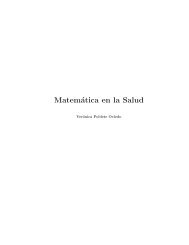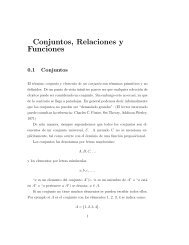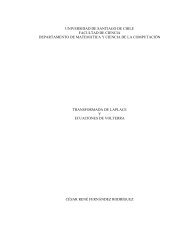Apuntes de Variable Compleja - Carlos Lizama homepage ...
Apuntes de Variable Compleja - Carlos Lizama homepage ...
Apuntes de Variable Compleja - Carlos Lizama homepage ...
You also want an ePaper? Increase the reach of your titles
YUMPU automatically turns print PDFs into web optimized ePapers that Google loves.
Capítulo 5<br />
Polos y residuos<br />
5.1. Desarrollo en serie <strong>de</strong> Laurent<br />
Teorema 64 Sea f(z) una función analítica en un anillo (o corona) r < |z −<br />
z0| < R.Entonces f(z) se pue<strong>de</strong> representar por una serie <strong>de</strong> la forma<br />
f(z) = <br />
an(z − z0) n + bn<br />
(z − z0) n<br />
n≥0<br />
que converge uniformemente en compactos <strong>de</strong> ese anillo. A<strong>de</strong>más:<br />
1) La primera serie converge en |z − z0| < R<br />
2) La segunda serie converge en |z − z0| > r<br />
Demostración. Sean γ1 y γ2 circulos <strong>de</strong> radios r ′ y R ′ respectivamente, con<br />
r < r ′ < R ′ < R.<br />
Por la fórmula <strong>de</strong> Cauchy en el anillo r ′ ≤ |z − z0| ≤ R ′ se tiene:<br />
f(z) = 1<br />
<br />
2π γ<br />
= 1<br />
2π<br />
con γ = γ2 − γ1<br />
Proce<strong>de</strong>mos ahora como sigue:<br />
En γ2:<br />
Entonces<br />
1<br />
(s − z) =<br />
1<br />
s − z0 + z0 − z<br />
<br />
1<br />
2πi γ2<br />
<br />
γ2<br />
f(s)<br />
(s − z) ds<br />
n≥1<br />
f(s) 1<br />
ds −<br />
(s − z) 2π<br />
= 1<br />
s − z0<br />
f(s)<br />
(s − z)<br />
1<br />
1 − z−z0<br />
s−z0<br />
<br />
γ1<br />
= <br />
f(s)<br />
(s − z) ds<br />
n≥0<br />
<br />
ds = an(z − z0) n<br />
34<br />
n≥0<br />
1<br />
(s − z0) n+1 (z − zn 0 )







